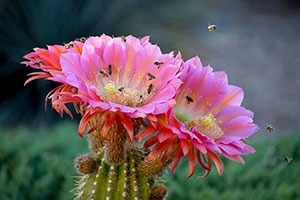A University of Wyoming scientist’s research has shown that honey bees carrying nectar have the amazing ability to modify their flight behavior to prevent overheating when air temperatures rise.
 Honey bees draw nectar from a cactus. Image Credit: Jon Harrison Photo
Honey bees draw nectar from a cactus. Image Credit: Jon Harrison Photo
The study was carried out by Postdoctoral Research Associate Jordan Glass of the University of Wyoming’s Department of Zoology and Physiology to ascertain how high air temperatures might affect honey bees’ capacity to forage for nectar.
The results of Glass’s research have been published in Proceedings of the National Academy of Sciences, one of the most esteemed multidisciplinary scientific journals in the world that covers the social, physical, and biological sciences.
Pollinators are disappearing at a startling rate, partly because of climate change. Although it is generally believed that a honey bee’s ability to forage should be restricted in extremely hot and dry conditions, Glass and colleagues discovered that these pollinating insects can actually continue to work in extremely hot temperatures. According to this study, honey bees can survive in temperatures between 77 and 104 ℉ and still carry the same amount of nectar.
In order to assess the honey bees’ capacity to fly in hot weather, the researchers took measurements of their flight muscles, metabolism, and water loss while they were carrying nectar inside a temperature-controlled flight chamber.
Additionally, the scientists measured alterations in the flying bees’ wing-flapping patterns using high-speed videos to ascertain whether carrying nectar would affect their flight behavior.
Their findings specifically showed that their metabolism and flight muscle temperatures rose when the honey bees carried nectar at 68 and 86 °F. But at 104 °F, flight metabolism only marginally increased with increasing nectar loads, and muscle temperatures remained unchanged.
High-speed recordings of honey bees flying in 77 ºF and 104 °F air were analyzed to reveal that, at high body temperatures, “bees apparently increase flight efficiency by lowering their wingbeat frequency and increasing stroke amplitude to compensate, reducing the need for evaporative cooling,” adds Glass, who led the research as a doctoral student at Arizona State University.
Put another way, bees adapt their flight patterns as temperatures rise to release less heat during metabolism. This helps the insects prevent overheating and conserve water.
Due to the capacity of hot bees to reduce metabolic heat production during flight, our data suggest that, under dry and poor forage conditions, (dehydration) may limit activity before overheating, impairing critical pollination services provided by honey bees. Even with reductions in metabolic heat production, (dehydration) likely limits foraging at temperatures well below bees’ critical thermal maxima in hot, dry conditions.”
Jordan R. Glass, Lead Researcher and Doctoral Student, Department of Zoology and Physiology, University of Wyoming
Glass says there is still cause for concern as the globe gets warmer and drier, even though the study’s findings allay some worries about how a warming climate will affect honey bees.
Source:
Journal reference:
Glass, R. J., et.al. (2023) Flying, nectar-loaded honey bees conserve water and improve heat tolerance by reducing wingbeat frequency and metabolic heat production. Proceedings of the National Academy of Sciences (PNAS). https://doi.org/10.1073/pnas.2311025121